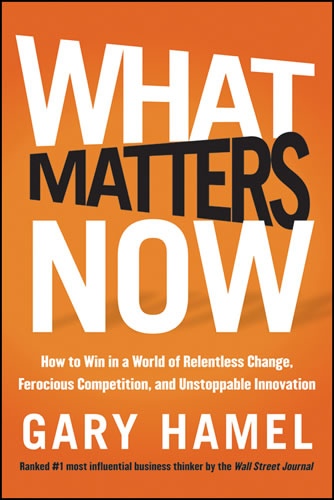
This book isn’t for people who like their management structure, like safety of working in a hierarchical model, or like entrusting their future to others that are wiser than they are. This book is for people who believe that traditional business models are broken and are longing for something better.
Instead of promoting the usual management “feel-good” strategies, Gary Hamel touches on core problems and offers some innovative hope:
- Why is it that as managers we are perfectly willing to accept the idea of a company dedicated to timeless human values, but are, in general, unwilling to become practical advocates for those values within our own organizations?
- …if you’re a consultant who helps other folks to innovate, you may be one “spending freeze” away from posting yourself at a busy intersection with a hand-lettered sign that reads, “Will brainstorm for food.”
- If you want a measure of just how difficult it is to stay innovative, consider this: two-thirds of the businesses on Fast Company‘s 2009 list of the 50 most innovative companies didn’t make it into the 2010 edition.
- What limits innovation in established companies isn’t a lack of resources or a shortage of human creativity, but a dearth of pro-innovation processes (employees don’t regularly practice innovation).
- The perceptual habits of successful innovators: unchallenged orthodoxies (“what are our business assumptions?”), under-appreciated trends (“what’s changing now?”), under-leveraged competencies and assets (“what are we really good at?”), and unarticulated needs (“what emotional clues are we missing?”).
- How can your company duplicate Apple’s success? Be passionate. Lead, don’t follow. Aim to surprise. Be unreasonable. Innovate incessantly and pervasively. Think like an engineer, feel like an artist.
- Why does excellence die? Gravity wins (big companies are harder to change than smaller), strategies die (planned actions are out-of-sync with real-world results), and success corrupts (defensive mindset).
- 21% of employees surveyed (from 2007-2008 Global Workforce Summary) were truly engaged in their work, 38% were mostly or entirely disengaged, with the rest in the middle. What’s wrong with business-as-usual?
- A hierarchy of human capabilities at work: Passion > Creativity > Initiative > Expertise > Diligence > Obedience. The last 3 capabilities are commodity skills.
- It’s not because work sucks; it’s because management blows.
- Create human-centered organizations (such as: Gore, Whole Foods Market, Morning Star Company, and HCL Technologies):
- Decentralize wherever possible
- Emphasize community over hiearchy
- Ensure transparency in decision making
- Make leaders more accountable to the led
- Align rewards with contribution, rather than with power & position
- Substitute peer review for top-down review
- Steadily enlarge the scope of self-determination
- A Manager’s goal is to maintain status quo. A leader’s goal is to break it.
- “Moonshots” (audacious goals) for management innovation: mending the soul, unleashing capabilities, fostering renewal, distributing power, seeking harmony, and reshaping minds.
Bonus: Listen to Gary talk about his book at this recent Commonwealth Club event.